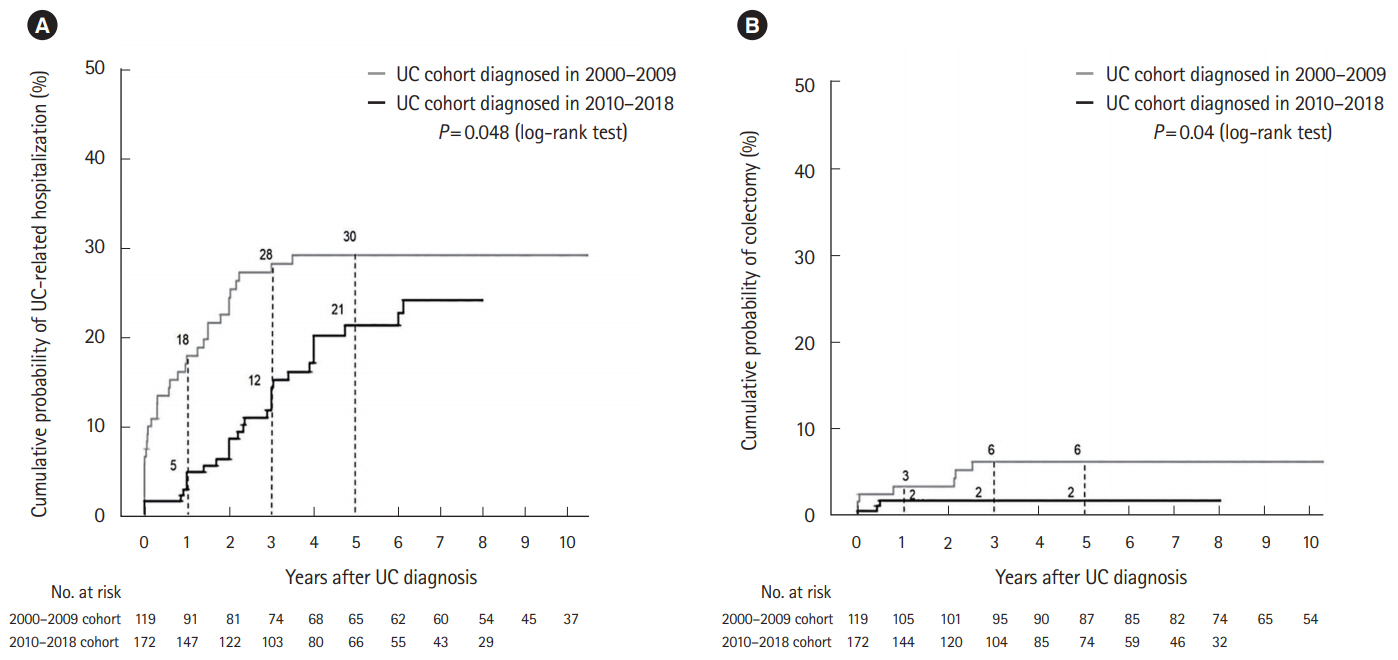Intest Res.
2021 Apr;19(2):186-193. 10.5217/ir.2020.00028.
Temporal trend in the natural history of ulcerative colitis in a country with a low incidence of ulcerative colitis from 2000 through 2018
- Affiliations
-
- 1Division of Gastroenterology, Faculty of Medicine, Chulalongkorn University, Bangkok, Thailand
- 2King Chulalongkorn Memorial Hospital, The Thai Red Cross Society, Bangkok, Thailand
- 3Division of Gastroenterology, Department of Internal Medicine, Faculty of Medicine, Siriraj Hospital, Bangkok, Thailand
- KMID: 2515477
- DOI: http://doi.org/10.5217/ir.2020.00028
Abstract
- Background/Aims
The incidence of ulcerative colitis (UC) in Thailand (crude incidence rate of 0.28 per 100,000 persons) is much lower than in the West. The burden of UC varies in different populations. The aim of this study was to evaluate the natural history of UC over the two decades in Bangkok, Thailand.
Methods
This retrospective study included patients who were diagnosed with UC between 2000 and 2018 in 2 university hospitals. To evaluate changes in the disease course, we stratified patients into 2000–2009 cohort and 2010–2018 cohort. The cumulative probability of endoscopic healing, UC-related hospitalization and colectomy was estimated using the Kaplan-Meier method.
Results
A total of 291 UC patients were followed for total of 2,228 person-years. Comparison between 2 cohorts, there were no differences in disease pattern and severity whereas an increase in the combination use of oral and topical mesalamine and the early use of thiopurine was observed. Only 1% of patients for each cohort required biologic agent at 5 years. The rate of achieving mucosal healing increased from 15% to 46% at 3 years (P< 0.01). The rate of UC-related hospitalization decreased from 30% to 21% at 5 years (P< 0.05). The rate of colectomy decreased from 6% to 2% at 5 years (P< 0.05).
Conclusions
The natural history of UC in a low incidence country was less aggressive than the West. Over the past two decades, the rates of UC-related hospitalization and colectomy have been decreasing which were similar to the West.
Figure
Cited by 2 articles
-
Update on the epidemiology of inflammatory bowel disease in Asia: where are we now?
Sang Hyoung Park
Intest Res. 2022;20(2):159-164. doi: 10.5217/ir.2021.00115.Natural history of inflammatory bowel disease: a comparison between the East and the West
Eun Mi Song, Suk-Kyun Yang
Intest Res. 2022;20(4):418-430. doi: 10.5217/ir.2021.00104.
Reference
-
1. Ng SC, Shi HY, Hamidi N, et al. Worldwide incidence and prevalence of inflammatory bowel disease in the 21st century: a systematic review of population-based studies. Lancet. 2018; 390:2769–2778.
Article2. Aniwan S, Harmsen WS, Tremaine WJ, Kane SV, Loftus EV Jr. Overall and cause-specific mortality of inflammatory bowel disease in Olmsted county, Minnesota, from 1970 through 2016. Mayo Clin Proc. 2018; 93:1415–1422.
Article3. Fumery M, Singh S, Dulai PS, Gower-Rousseau C, Peyrin-Biroulet L, Sandborn WJ. Natural history of adult ulcerative colitis in population-based cohorts: a systematic review. Clin Gastroenterol Hepatol. 2018; 16:343–356.
Article4. Ng SC, Tang W, Ching JY, et al. Incidence and phenotype of inflammatory bowel disease based on results from the Asiapacific Crohn’s and colitis epidemiology study. Gastroenterology. 2013; 145:158–165.
Article5. Loftus EV Jr, Silverstein MD, Sandborn WJ, Tremaine WJ, Harmsen WS, Zinsmeister AR. Ulcerative colitis in Olmsted County, Minnesota, 1940-1993: incidence, prevalence, and survival. Gut. 2000; 46:336–343.
Article6. Shah SC, Khalili H, Gower-Rousseau C, et al. Sex-based differences in incidence of inflammatory bowel diseases-pooled analysis of population-based studies from western countries. Gastroenterology. 2018; 155:1079–1089.
Article7. Eriksson C, Cao Y, Rundquist S, et al. Changes in medical management and colectomy rates: a population-based cohort study on the epidemiology and natural history of ulcerative colitis in Örebro, Sweden, 1963-2010. Aliment Pharmacol Ther. 2017; 46:748–757.
Article8. Ng SC, Zeng Z, Niewiadomski O, et al. Early course of inflammatory bowel disease in a population-based inception cohort study from 8 countries in Asia and Australia. Gastroenterology. 2016; 150:86–95.
Article9. Vester-Andersen MK, Prosberg MV, Jess T, et al. Disease course and surgery rates in inflammatory bowel disease: a population-based, 7-year follow-up study in the era of immunomodulating therapy. Am J Gastroenterol. 2014; 109:705–714.
Article10. Jeuring SF, Bours PH, Zeegers MP, et al. Disease outcome of ulcerative colitis in an era of changing treatment strategies: results from the Dutch population-based IBDSL cohort. J Crohns Colitis. 2015; 9:837–845.
Article11. Vegh Z, Burisch J, Pedersen N, et al. Incidence and initial disease course of inflammatory bowel diseases in 2011 in Europe and Australia: results of the 2011 ECCO-EpiCom inception cohort. J Crohns Colitis. 2014; 8:1506–1515.
Article12. Targownik LE, Tennakoon A, Leung S, Lix LM, Singh H, Bernstein CN. Temporal trends in initiation of therapy with tumor necrosis factor antagonists for patients with inflammatory bowel disease: a population-based analysis. Clin Gastroenterol Hepatol. 2017; 15:1061–1070.
Article13. Ford AC, Khan KJ, Achkar JP, Moayyedi P. Efficacy of oral vs. topical, or combined oral and topical 5-aminosalicylates, in ulcerative colitis: systematic review and meta-analysis. Am J Gastroenterol. 2012; 107:167–176.
Article14. Eriksson C, Rundquist S, Cao Y, Montgomery S, Halfvarson J. Impact of thiopurines on the natural history and surgical outcome of ulcerative colitis: a cohort study. Gut. 2019; 68:623–632.
Article15. Ungaro R, Colombel JF, Lissoos T, Peyrin-Biroulet L. A treat-to-target update in ulcerative colitis: a systematic review. Am J Gastroenterol. 2019; 114:874–883.
Article16. Mokhtar NM, Nawawi KNM, Verasingam J, et al. A four-decade analysis of the incidence trends, sociodemographic and clinical characteristics of inflammatory bowel disease patients at single tertiary centre, Kuala Lumpur, Malaysia. BMC Public Health. 2019; 19:550.
Article17. Ng SC, Kaplan GG, Tang W, et al. Population density and risk of inflammatory bowel disease: a prospective population-based study in 13 countries or regions in Asia-Pacific. Am J Gastroenterol. 2019; 114:107–115.
Article



